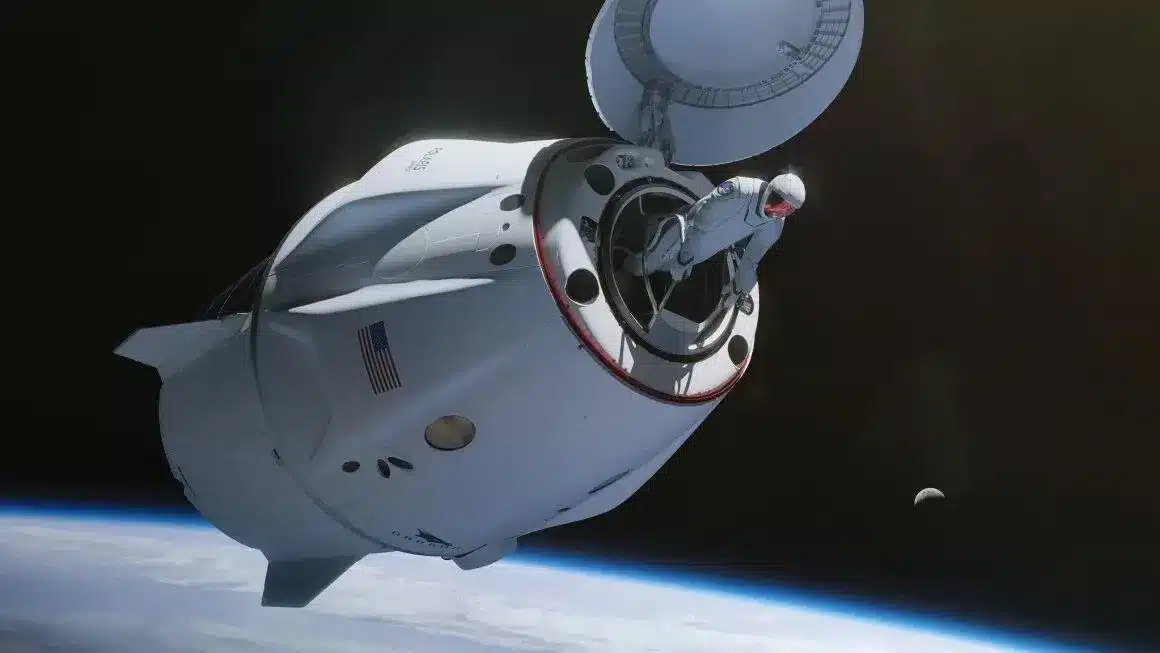About Polaris Dawn Mission:
- Polaris Dawn is set to be the first non-governmental mission to conduct a spacewalk, reaching an unprecedented altitude of approximately 700 kilometres (435 miles) above Earth.
- This altitude surpasses that of the International Space Station (ISS), which orbits at about 400 kilometres.
- Spacecraft: SpaceX will provide the Falcon 9 rocket and Dragon capsule for the mission. The spacecraft will attempt to break the altitude record set by NASA’s Gemini 11 mission in 1966, which reached 1,373 kilometres.
- Crew and leadership: The mission is spearheaded by billionaire entrepreneur Jared Isaacman, who previously financed and flew on SpaceX’s Inspiration4 mission, the first civilian mission to orbit Earth.
Understanding the Van Allen Belts:
- Composition: The Van Allen Belts consist of charged particles trapped by Earth’s magnetosphere, which protects the planet from solar storms and cosmic rays.
- These belts were first identified in 1958 by the American physicist James Van Allen.
- Location: The belts are divided into two types:
- Inner belt: Located between 680 and 3,000 kilometres above the Earth’s surface, this belt is primarily composed of high-energy protons. It forms due to the interaction between cosmic rays and Earth’s atmosphere.
- Outer belt: Situated at altitudes ranging from 15,000 to 20,000 kilometers above the Earth’s surface, the outer belt predominantly consists of high-energy electrons originating from the solar wind.
- Radiation risks: The spacewalk during Polaris Dawn will expose the crew to higher levels of radiation than those on the ISS.
- The charged particles within these belts can lead to radiation sickness, harm to human tissues, and an increased risk of cancer.
- Data collected during this mission will be crucial for future deep-space missions, including NASA’s planned 2025 mission to the Moon and Mars.
Significance of the Spacewalk:
- Van Allen belts: The mission will involve orbiting through the Van Allen Belts, regions of intense radiation that astronauts typically avoid. The ability to navigate these belts is crucial for future missions to Mars.
- Testing new spacesuits: The four astronauts on board will test new spacesuits developed by SpaceX. These suits are designed to protect against the heightened radiation found in the Van Allen Belts.
Planned health research:
- Biological effects of space travel: Polaris Dawn aims to create research biobanks to study how space travel impacts human biology, including eyesight and brain structure.
- These studies address Spaceflight-Associated Neuro-ocular Syndrome (SANS), a significant health risk in space.
- Decompression sickness: The mission will also contribute to research on decompression sickness (DCS), a condition caused by nitrogen gas bubbles damaging human tissue during spaceflight.
Innovation in space communications:
- Laser communications test: The crew will test laser communications provided by SpaceX’s Starlink satellite network.
- This technology is vital for future space missions to the Moon, Mars, and beyond. The data from these tests will inform the development of advanced space communication systems.
Polaris Missions ahead:
- Mission progression: Isaacman has committed to three Polaris missions in collaboration with SpaceX. The first mission is planned to last five days, with future missions set to push the boundaries of human spaceflight, communications, and scientific research.
Starship test: The third Polaris mission will involve the first crewed test of SpaceX’s reusable Starship spacecraft.
Q1. What is the GSAT Series of satellites?
The GSAT (Geostationary Satellite) series represents a remarkable constellation of communication satellites that have been developed by the esteemed Indian Space Research Organisation (ISRO). These satellites play an indispensable and pivotal role in a wide array of communication services, encompassing vital areas such as telecommunication, broadcasting, and broadband connectivity.
Source: Polaris Dawn: Another small step to Mars? | Explained News – The Indian Express
Last updated on June, 2025
→ UPSC Notification 2025 was released on 22nd January 2025.
→ UPSC Prelims Result 2025 is out now for the CSE held on 25 May 2025.
→ UPSC Prelims Question Paper 2025 and Unofficial Prelims Answer Key 2025 are available now.
→ UPSC Calendar 2026 is released on 15th May, 2025.
→ The UPSC Vacancy 2025 were released 1129, out of which 979 were for UPSC CSE and remaining 150 are for UPSC IFoS.
→ UPSC Mains 2025 will be conducted on 22nd August 2025.
→ UPSC Prelims 2026 will be conducted on 24th May, 2026 & UPSC Mains 2026 will be conducted on 21st August 2026.
→ The UPSC Selection Process is of 3 stages-Prelims, Mains and Interview.
→ UPSC Result 2024 is released with latest UPSC Marksheet 2024. Check Now!
→ UPSC Toppers List 2024 is released now. Shakti Dubey is UPSC AIR 1 2024 Topper.
→ Also check Best IAS Coaching in Delhi
























